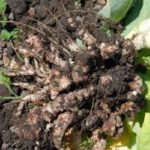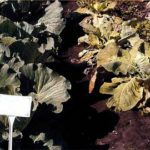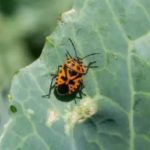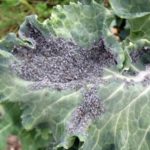June is one of the old, time-tested varieties of cabbage. Breeding work to create an ultra early variety, which is particularly resistant to spring frosts, was carried out in 1967 by employees of the All-Russian Research Institute for Vegetable Breeding.
Table of contents
- Characteristics and botanical description of the variety
- The advantages and disadvantages of the variety
- Terms of planting vegetables on seedlings
- Growth conditions for June cabbage
- Soil preparation for cultivation
- The main aspects of planting cabbage in open ground
- Proper care after planting
- Diseases and their prevention
- Harvesting and storage rules
Characteristics and botanical description of the variety
June cabbage belongs to the early varieties. The period from germination to technical ripeness is 92-100 days.
The plant has a compact leaf rosette, which is raised and has a diameter of 40-50 cm. The leaves are painted green, solid, with a slight waxy coating, the edges of the leaf plates are slightly wavy.
The powerful and large plant forms the heads of spherical shapes of medium density. Outside the color is light green, on the cut has a light green tint. Internal stalk of moderate length. Heads of cabbage are characterized by richness, uniformity and weight from 1.2 to 2.5 kg. The product contains solids in the amount of 8.1%, sugars - up to 3.8% and ascorbic acid - 45mg.
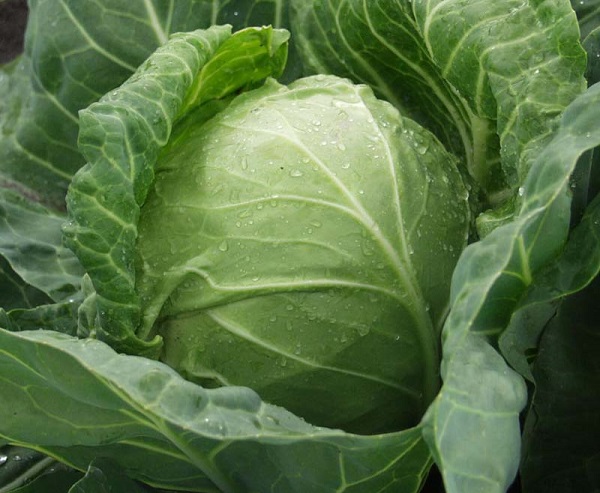
The advantages and disadvantages of the variety
The advantages due to which the variety is in good demand with gardeners include:
- stable and high yields, up to 6 kg per 1 square meter;
- harmonious ripening of fruits, allowing to grow crops for early marketable products;
- good consumer taste and delicate structure of vegetables;
- the ability of seedlings to tolerate low temperatures;
- source of nutrients, especially vitamin C.
In addition to the positive characteristics, there are also disadvantages of the variety, namely;
- the tendency to cracking heads, therefore, requires cleaning in a timely manner;
- low rates of keeping quality, which are typical for all early varieties;
- Vegetables are intended only for fresh consumption and are not suitable for ferment.
Terms of planting vegetables on seedlings
Cabbage seed does not require special preparation. Choosing time for sowing, it is required to calculate when to plant cabbage on seedlings so that in June it would be possible to cut off the first forks. Cabbage should be planted at a certain time, but depending on the climate conditions of the region: from the beginning of March to May. If you sow cabbage in early March, then plant it in a permanent place at the end of April, otherwise the seedlings will outgrow, which will negatively affect its fruiting.
For early harvest with the least effort, knowledgeable gardeners recommend sowing the crop at the end of March. Then planting seedlings can be carried out in the first decade of May. This period is considered traditional for planting seedlings in the ground in regions with a temperate climate.
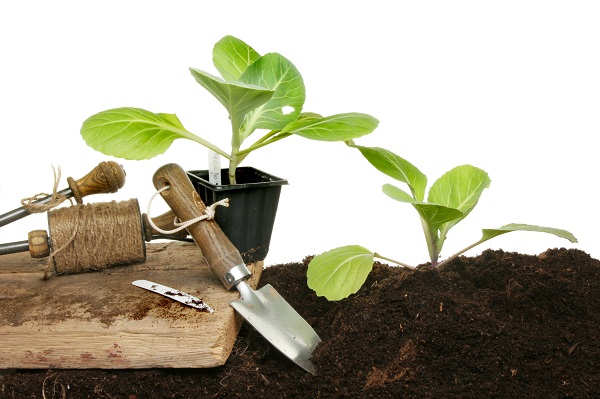
Growth conditions for June cabbage
Planting culture begins with the selection of the site, which must be well lit by the rays of the sun throughout the day. The best option would be to take a level or with a small slope to the south and south-east place.
Culture prefers fertile, loamy soil. If the soil is acidic, then it must be subjected to liming, because at pH less than 6.0 cabbage is not capable of tying cabbages, and is highly susceptible to keel.
Soil preparation for cultivation
Growing cabbage, you need to consider that to obtain a generous guaranteed yield, the preparation of the soil is of great importance. The plant is demanding on the structure and fertility of the soil. Therefore, for planting it is necessary to use only fertilized soil and this should be done in advance.
For this purpose, the area set aside for planting needs to be dug up from the fall with a shovel and equipped with humus and ash, which is considered a good antiseptic to prevent the development of rotting. We should not forget about mineral fertilizers, and add superphosphate and potassium chloride to the soil. With the onset of spring to loosen the site and also make a complex of nutrients.
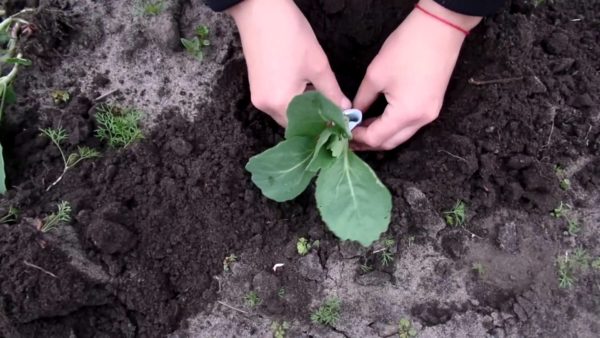
The main aspects of planting cabbage in open ground
When the weather is favorable, you can plant seedlings. Before planting, the plants should have four true leaves. Close up the seedlings in the wells should not be very deep on the first true leaf, and trying not to damage the root system. You can not fall asleep growth point. The soil around the cabbage is slightly compacted and watered thoroughly.
Proper care after planting
The plant requires a lot of attention from the gardener, constant care and the provision of favorable conditions for growth. For full development and obtaining a decent crop of cabbage, you must perform the following set of measures:
- defective seedlings to protect from direct sunlight, as the variety does not tolerate strong heat;
- during the week after planting, young plants spray water three times a day, using a watering can;
- keep cabbage beds clean, removing weeds and spuding growing plants;
- on time to carry out high-quality watering, because the culture is very in need of moisture, and the slightest drying of the earthy coma leads to stiffening of the stalk and the cessation of root growth;
- to provide growing cabbage with nutritious elements, by applying complex organic and mineral fertilizers;
- inspect the plant for the appearance of insects, not losing the moment when their population begins to actively develop, and in the event of a problem not to use chemistry, but to give preference to the popular or biological means.
Competent care guarantees early receipt of high quality vegetables.
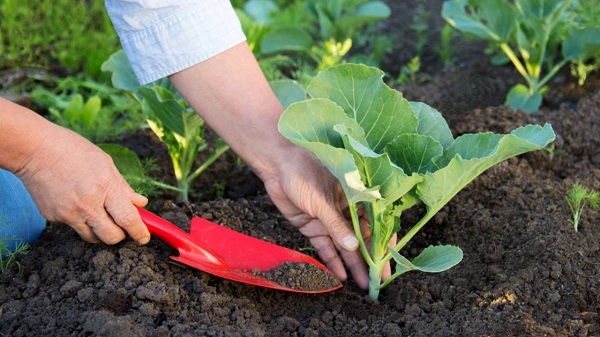
Diseases and their prevention
Cabbage, like any vegetable crop, is subjected to a huge number of pests and diseases and requires the implementation of appropriate control measures.
| DISEASES | |||
| Title | Description | Control measures | |
| Quila | The presence of growths on the root system, which do not allow the small roots to develop | Sick specimens should be removed and burned, the soil should be disinfected with disinfectants and
for 4 years, do not plant cabbage at this place. |
|
| Fusarium wilt | Yellowing and wilting of the leaves, which subsequently fall off, and left a bare trunk with a rosette of leaves at the crown. As a result, under the influence of infection, plant growth stops | The disease is not amenable to treatment. To prevent the infection from spreading, diseased plants should be removed from the beds together with the earth clod.
|
|
| Blackleg | The thin root neck and base of the stem turn black and begin to rot, due to which the plant stops developing and subsequently dies. | An infected plant cannot be cured; it must be removed from the bed and burned and disinfected with appropriate preparations. | |
| PESTS | |||
| Cruciferous bugs | Insects pierce the skin of the culture and suck the sap from the leaves, while the leaves curl and the plant dies | If the culture is affected in the initial stages, you need to fight, using time-tested folk remedies.With a strong multiplication of parasites need to deal with them with chemicals
|
|
| Cabbage Aphid | A green insect attacks a plant, weakens it, and disrupts metabolic processes. | ||
Compliance with all standards of agricultural culture to growing conditions, will allow plants to actively and successfully resist pathogens and dangerous insects.
- Kela cabbage
- Fusarium wilt
- Black leg cabbage seedlings
- Cruciferous bug
- Cabbage Aphid
Harvesting and storage rules
According to the description of the variety, the head of cabbage ripens at the same time at the end of June, after 55-60 days after transplanting. It is possible to determine the readiness of a culture for harvesting by external signs. If the vegetable head is solid and has reached the required size, then you can begin to harvest. Also, the signal for harvesting is the yellowing of the outer lower leaves in mature vegetables, which indicates the completion of the process of growth and storage of nutrients.
It is desirable to collect in the morning in dry cool weather. Cut vegetables carefully, using a sharp knife. At the same time you need to leave three sheets and a stalk length of 2 cm.
Long stored cabbage June is not capable. It is intended to be eaten no later than 2 weeks after cleaning.
For quality products, you need to make some efforts, as well as know certain features of this culture. It is important to provide cabbage with comfortable conditions and in June enjoy the excellent taste of healthy and fresh vegetables.

